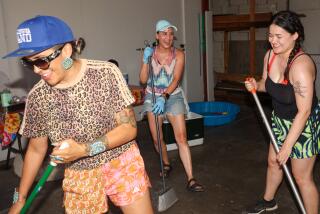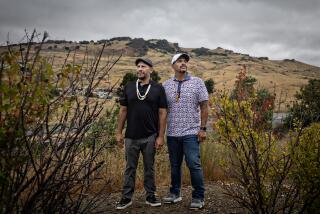Native Americana
- Share via
About 100 Native American artisans, dancers and storytellers gathered to show and sell their art last month at the Southwest Museum’s 11th Annual Intertribal Marketplace. The event featured storytellers, musicians and dancers along with traditional fare such as fry bread and tamales. We asked some artists what fills their palettes.
Audie Yazzie
42, Navajo, Glendale Sand painter, jewelry artist
How did you learn your art?
I taught myself.
What makes sand painting special?
It’s temporary. It’s a healing ceremony. It starts early in the morning, it’s done by noon, and it’s destroyed by night.
Why make traditional art today?
I’d like to see other generations appreciate it.
Favorite Native American word or expression?
Yah-ta-hey. It’s “hello” in Navajo. It’s a way to greet people.
As head of the tribes for one day, what would you do?
I wish everyone could get along with other Indian nations.
Eva Salazar
23, Kumeyaay, San Diego
Basket weaver, doll maker
How did you learn your art?
I learned the willow basket weaving from my mom and the juncus baskets from my aunt.
Do you follow strict tradition or experiment?
I follow strict tradition with the baskets. I experiment only when creating dolls.
Why make traditional art today?
People like the baskets, but not a lot of people make them anymore.
Favorite Native American word or expression?
Tilpu. It means “roadrunner,” and it’s my youngest son’s name.
As head of the tribes for one day, what would you do?
I’d get farm machines for the reservation. I’d fix the roads. I’d build a museum.
Frankie Florez
25, Chumash and Apache, Ventura
Traditional dancer
How did you learn your art?
I’ve been going to weekly pow-wows. I talked to elders in the Indian community.
Why perform traditional dance today?
You don’t know where you’re going if you don’t know where you’ve been.
Favorite Native American word or expression?
Haku. It’s a Chumash word for “hello” or greeting people. There’s no word for goodbye.
As head of the tribes for one day, what would you do?
I’d feed everyone. It’s a great honor to feed everyone.
Jacques L. Condor
74, Mesquaki-Abenaki-Tsimshian, Yucaipa, Storyteller
Tell us about your tribal heritage.
Father was of the Algonquin culture [which includes the Mesquaki-Abenaki tribes]. Mother was Tsimshian.
How did you learn your art?
From my family. I come from a generation with no electricity. We told stories. I also have an MFA from the University of Colorado.
What drew you to this art form?
Wah-wah-seh soki, “the fire within.” Everything has it--trees, people. I don’t want the stories lost.
Why perform traditional art today?
It’s a mind developer. In this electronic and digital age, children don’t use their imagination.
Favorite Native American word or expression?
Kitchi-Migwitch. It means “many thanks.”
As head of the tribes for one day, what would you do?
I’d say, “Pan-Indianism is an impossibility.” There’s not one type of Indian. Unity through diversity.
More to Read
The biggest entertainment stories
Get our big stories about Hollywood, film, television, music, arts, culture and more right in your inbox as soon as they publish.
You may occasionally receive promotional content from the Los Angeles Times.










